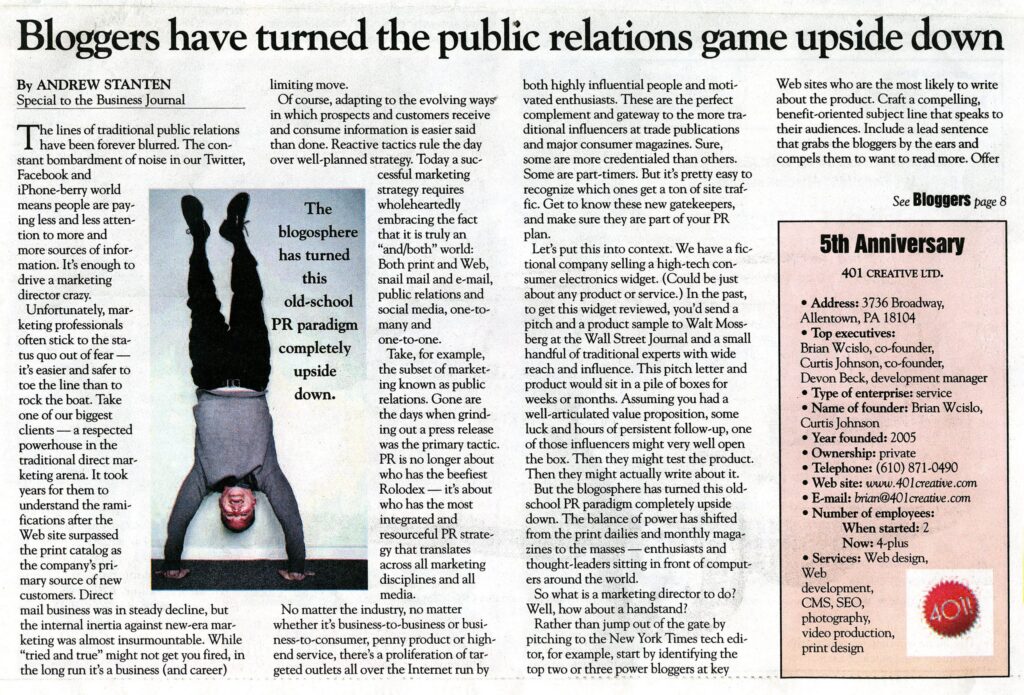The lines of traditional public relations have been forever blurred.
The constant bombardment of noise in our Twitter, Facebook and iPhone-berry world means people are paying less and less attention to more and more sources of information. It’s enough to drive a marketing director crazy.
Unfortunately, marketing professionals often stick to the status quo out of fear–it’s easier and safer to toe the line than to rock the boat. Take one of our biggest clients–a respected powerhouse in the traditional direct marketing arena. It took years for them to understand the ramifications after the website surpassed the print catalog as the company’s primary source of new customers. Direct mail business was in steady decline, but the internal inertia against new-era marketing was almost insurmountable. While “tried and true” might not get you fired, in the long run it’s a business (and career) limiting move.
Of course, adapting to the evolving ways in which prospects and customers receive and consume information is easier said than done. Reactive tactics rule the day over well-planned strategy. Today a successful marketing strategy requires wholeheartedly embracing the fact that it is truly an “and/both” world: Both print and web, snail mail and email, public relations and social media, one-to-many and one-to-one.
Take, for example, the subset of marketing known as “public relations.” Gone are the days when grinding out a press release was the primary tactic. PR is no longer about who has the beefiest Rolodex–it’s about who has the most integrated and resourceful PR strategy that translates across all marketing disciplines and all media.
No matter the industry…no matter whether it’s business-to-business or business-to-consumer, penny product or high-end service…there’s a proliferation of targeted outlets all over the internet run by both highly influential people and motivated enthusiasts. These are the perfect complement and gateway to the more traditional influencers at trade publications and major consumer magazines. Sure, some are more credentialed than others. Some are part-timers. But it’s pretty easy to recognize which ones get a ton of site traffic. Get to know these new gatekeepers and make sure they are part of your PR plan.
Let’s put this into context. We have a fictional company selling a high-tech consumer electronics widget. (Could be just about any product or service.) In the past, to get this widget reviewed, you’d send a pitch and a product sample to Walt Mossberg at the Wall Street Journal and a small handful of traditional experts with wide reach and influence. This pitch letter and product would sit in a pile of boxes for weeks or months. Assuming you had a well-articulated value proposition, some luck and hours of persistent follow-up, one of those influencers might very well open the box. Then they might test the product. Then they might actually write about it.
But the blogosphere has turned this old-school PR paradigm completely upside down. The balance of power has shifted from the print dailies and monthly magazines to the masses–enthusiasts and thought-leaders sitting in front of computers around the world.
So what is a marketing director to do? Well, how about a handstand?
Rather than jump out of the gate by pitching to New York Times tech editor, for example, start by identifying the top two or three power bloggers at key websites who are the most likely to write about the product. Craft a compelling, benefit-oriented subject line that speaks to their audiences. Include a lead sentence that grabs the blogger by the ears and compels them to want to read more. Offer to send the product. Include a link for more information and product image download. Include nothing as an attachment until you establish a relationship. And get in and out in about 100 words–the size of this paragraph.
Okay, some disclosure–this isn’t about a fictional company. This actually happened. New media has a voracious appetite for fresh daily content, and many bloggers will post press releases nearly verbatim. In the case of this high-tech electronic widget, the initial blog posts simply noted that the product existed and was available for sale. These posts were quickly picked up by a dozen other related but smaller sites. Then a dozen more. This in turn led to a solid list of highly qualified tech blogs calling us, asking for review units. We sent these out and immediately blog reviews and viewer comments followed. These in turn were picked up by other sites.
After three months and more than 200 electronic media hits all around the world, guess who picked up the phone and asked us for a review unit? Guess who wanted to book an interview with the company CEO? Because enough people had been raving about the product, it caught the eye of one of those very same highly influential, traditional gatekeepers whom we sidestepped at the very beginning. The public relations paradigm has truly flipped upside-down.
To see this article as it originally appeared in the Eastern Pennsylvania Business Journal, click here.


